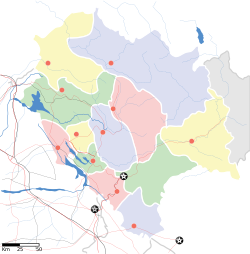Rampur, Himachal Pradesh
| Rampur रामपुर |
|
|---|---|
| city | |
| Location in Himachal Pradesh, India | |
| Coordinates: 31°27′0″N 77°37′59″E / 31.45000°N 77.63306°ECoordinates: 31°27′0″N 77°37′59″E / 31.45000°N 77.63306°E | |
| Country |
|
| State | Himachal Pradesh |
| District | Shimla |
| Elevation | 1,021 m (3,350 ft) |
| Population (2011) | |
| • Total | 5,655 |
| Languages | |
| • Official | Hindi |
| Time zone | IST (UTC+5:30) |
Rampur Bushahr is a city and a municipal council in Shimla district in the Indian state of Himachal Pradesh. It is 130 km from Shimla well connected with National Highway which passes through Narkanda (attitude 2708m).
The principality of Bashahr (also known as Bashahar, Bushahar, Bushahr) was once among the largest of the twenty-eight Shimla Hill States under the administration of the British Raj keen to invest on regional and transcontinental trade and exploit Himalayan resources. It bordered on the north with Spiti, on the east with Tibet, on the south with Garhwal, and on the west with Jubbal, Kotkhai, Kumharsain, Kotgarh, and Kullu. Caught in the machinations of the British imperial enterprise, it was subjected to political-cum-economic vicissitudes, acceding to the Indian Union in 1947. On 8 March 1948, along with twenty other princely hill States of Punjab and Shimla, Bashahr signed an agreement which resulted in its inclusion in the Indian State of Himachal Pradesh.
Rampur, a small township situated at 1,005 meters on the left bank of the Sutlej, served as Bushahar’s winter capital. Being well connected with major trading routes that joined Indian markets with Central Asia and Tibet, it buzzed with mercantile activity, especially in November during the Lavi fair, the largest trading event in the north Himalayas attracting traders from Kashmir, Ladakh, Yarkand, and the Indian mainland. Concerning the origins of the Rampuri fair, the Census of India (1961) reports:
"About three hundred years ago during the regime of Raja Kehar Singh of Bushahr, a trade treaty was signed between the Bushahr State and Tibet…Horses from Tibet and swords from Bushahr were exchanged in token of this friendship. It was written in the treaty that their friendly relations would continue till this time…Since then, it is presumed that trade relations increased and eventually [the] Lavi fair was held."
Rampur was also located along pilgrimage routes to sacred sites in western Tibet shared by Hindus, Bön and Buddhists alike, i.e., Mount Kailash and Lake Mansarovar. Missionary and pilgrimage activities, intensified by trading possibilities, created the conditions for Tibetan Buddhism to take a firm stronghold in these borderland regions. Twenty-two kilometres from the village of Namgya in upper Kinnaur, laid the Shipki pass which linked caravan routes to and from western Tibet. This treacherous transcontinental passage must have been in use from ancient times, for among the ruined castles reported by Francke at Shipki village, there were no living memories of the origins of mKar gog, the oldest of them built above the village in cyclopean style.Rampur also has Hydro Power Stations namely, Nathpa Jhakri Power Station (1500 MW) and Rampur Hydro Power Station (412 MW) by SJVN Ltd. A second castle, known as Seng ge mkhar, is said to have received its crooked ground plan “through a race round its base executed in opposite directions by a poisonous snake and a scorpion,” and was built, in all probability, during the Ladakhi occupation of mNga’ ris by orders of King Seng ge rnam rgyal (1570–1642) and called after him. It is 30 km from SAINJ.
...
Wikipedia


